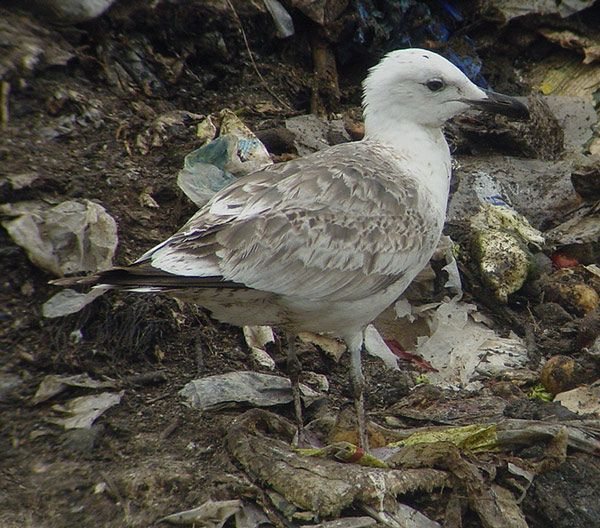 Heuglin's Gull - Siberische Meeuw (L. heuglini)
Heuglin's Gull - Siberische Meeuw (L. heuglini)
(last update:
|
Heuglini 2cy, July 11 2003, Tampere, Finland (61.33N 24.59E).
2cy Heuglini still remain a difficult plumage to recognise, but birds like this one are most probably reasonable safe to identify. Such 2cy birds on the Tampere dump in Finland in July show characteristics which normally do not associate with classical fuscus. The replaced second generation wing-coverts are bleached and worn and show obvious internal patterns and the third generation scapulars are slate grey with a black shaft-streak. Moult in the primaries follow the ordinary sequence of other taxa, with P1 and P2 growing, P3 missing and P4-P10 are still juvenile.
The complete moult in the winter quarters normally start with replacement of the scapulars and mantle-feathers in November to January, but the post-juvenile moult may already start in juvenile birds which are still in Scandinavia in September. The new scapulars often show a simple pattern of a black shaft-streak on a dark brown base. When most of the scapulars are replaced, fuscus start to replace the wing-coverts, in the ordinary sequence of the complete moult as can be found in other gull taxa in Europe. Wing-covert moult is initiated in two loci, one wave starts in the outermost coverts, one wave starts in the innermost coverts. The two waves normally meet at covert #7-8. Normally the median covert row is the first row which is moulted, followed by the lower lesser coverts, the greater coverts and moult finishes in the outer lesser coverts (the carpal edge). If for whatever reason, moult in the wing-coverts is not completed, this is normally most obvious in the carpal edge and outer greater coverts, containing juvenile feathers which contrast with the other fresh coverts. In classical 2cy fuscus, all wing-coverts are replaced to second generation on the wintering grounds, and by mid July in Scandinavia, a next moult is initiated, often including the median and lower lesser coverts, the inner greater coverts, upper tertials and scapulars. Bare part coloration may be very immature, including a black bill, but may also be very mature, with a yellow base and a red gonydeal spot on the lower mandible. Still, these birds are only 12 months old. |

